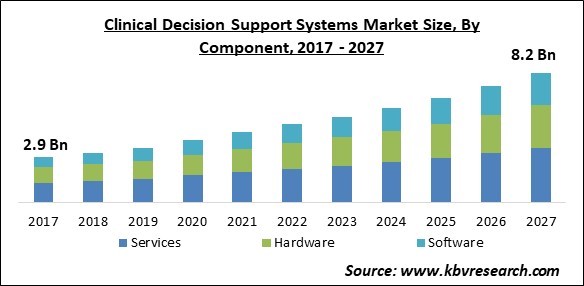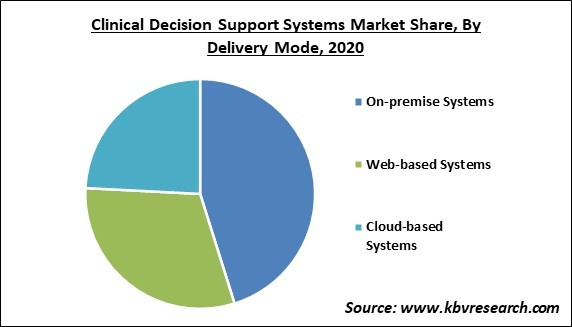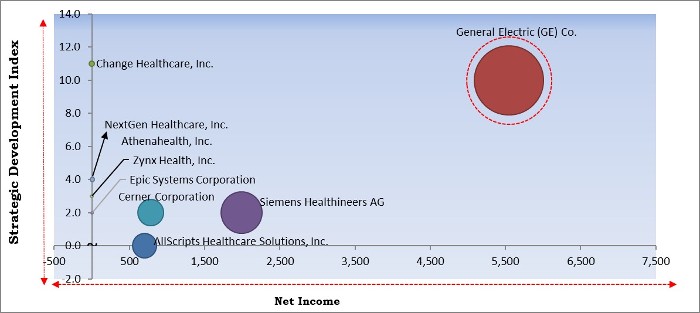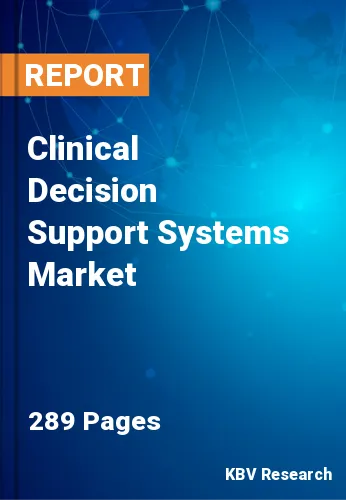The Global Clinical Decision Support Systems Market size is expected to reach $8.2 billion by 2027, rising at a market growth of 10.7% CAGR during the forecast period.
Clinical decision support systems (CDSS) are applications that are based on computers which collect and analyze data from electronic health records (EHRs) and offer cues and reminders to assist healthcare practitioners in following evidence-based clinical standards at the point of treatment. This Domain 3 strategy, when applied to CVD prevention, can help providers in a variety of ways, such as reminding them to screen for CVD risk factors, flagging cases of hypertension or hyperlipidemia, providing information on treatment protocols, prompting questions about medication adherence, and providing tailored recommendations for health behavior changes.
According to the World Ageing 2019 report, the world's population of people aged 65 and above was predicted to be 703 million in 2019. This group of people is prone to a variety of chronic diseases and requires regular health screenings and treatments to stay healthy. According to the current circumstances around the world, many people belonging to elderly and pregnant women segment, may require health examinations, but hospitals and clinics are unable to deliver these services owing to the global COVID-19 outbreak.
In recent years, a major increase in the number of hospitals and healthcare institutions that have adopted various forms and levels of clinical decision support systems has created a considerable opportunity for increased adoption in the near future. In industrialized regions, demand for decision assistance based on factual evidence and real-time knowledge has increased at a quicker adoption rate.
The number of agreements between CDSS providers and hospitals has increased significantly in recent years. Companies collaborate to develop and supply software that is up to date with the updated knowledge. The demand is expected to rise further as a result of government recognition and activities to stimulate the deployment of CDSS and EHR systems.

COVID-19 emerged as a very deadly infection that caused a significant number of deaths around the world. Additionally, the COVID-19 pandemic also devastated businesses across the world irrespective of their sizes. During the pandemic, the healthcare infrastructure of various companies failed due to the sudden outburst of the infection which resulted in an unexpected count of patients in urgent requirement of hospitalization. Resultantly, CDSS providers and groups have launched measures to aid in the fight against the pandemic.
CDSS has been shown to be an important weapon in the fight against COVID-19, demonstrating how healthcare teams can stay up to date on the newest COVID information and intelligence, hence improving the quality of treatment they give. Patients with a moderate to high chance of COVID-19 should have their COVID-19 test repeated, according to the Infectious Diseases Society of America.
Some of the growth catalysts for the market include the deployment of government policies boosting the adoption of HCIT solutions, rising government healthcare expenditure, and the availability of qualified IT experts in emerging countries around the world. Authorities in different countries are concentrating on revamping the healthcare management sector, which is currently confronting issues such as a statewide scarcity of doctors, underfunded rural health centers, overburdened metropolis hospitals, and confusing patient data systems.
In various studies, it has been found that CDSS enhances adherence to clinical guidelines. Traditional clinical guidelines and treatment pathways have been demonstrated to be challenging to apply in practice due to low physician adherence. The expectation that practitioners will read, internalize, and apply new standards has not been shown to be true. The rules implicitly contained in recommendations, on the other hand, can be literally encoded in CDSS. CDSS can take many different forms, including standardized order sets for a certain case, alerts to a specific protocol for the patients involved, testing reminders, and so on.
In a variety of areas, clinical decision support systems encounter significant technical obstacles. Biological systems are extremely complex, and a therapeutic choice may rely on a vast amount of potentially relevant information. When recommending a patient's course of treatment, an electronic evidence-based medicine system might take into account the patient's symptoms, medical history, family history, and genetics, as well as historical and geographical trends in disease occurrence and published clinical data on medicinal effectiveness.

Based on the Component, the Clinical delivery support systems market is categorized into Hardware, Software, and Services. In 2020, the hardware segment followed the services segment and obtained the second largest revenue share of the clinical decision support systems market. The increasing growth of this segment is attributed to the increasing manufacturing of CDSS in order to fulfill the demand of the healthcare sector. The hardware of these systems is widely being produced resulting in increasing the growth of this segment of the clinical decision support systems market.
Based on the Product, the Clinical decision support systems market is segmented into Standalone CDSS, Integrated CPOE with CDSS, Integrated E.H.R. with CDSS, and Integrated CDSS with CPOE & E.H.R. In 2020, the standalone CDSS segment dominated the clinical decision support systems market by acquiring the largest revenue share of the market. This is owing to the low cost and simplicity of standalone CDSS. CDSS products can be used independently or in conjunction with an EHR or CPOE, or both.
Based on the Delivery mode, the Clinical decision support systems market is divided into Web-based Systems, Cloud-based Systems, and On-premise Systems. In 2020, the web-based systems segment acquired the second-largest revenue share of the clinical decision support systems market. The increasing growth of this segment of the market is attributed to the rising adoption of modern computers as well as continuous developments along with the latest innovations in software development.
Based on the Application, the Clinical decision support systems market is segregated into Drug-drug Interactions, Drug Allergy Alerts, Clinical Reminders, Clinical Guidelines, Drug Dosing Support, and Others. In 2020, the clinical guidelines segment would showcase the promising growth rate during the forecasted period. Moreover, the growth of this segment accelerated due to the fact that the CDS system provides treatment and diagnosis guidelines. It pulls data from the knowledge base and applies it to treatment, offering therapeutic guidelines for the practitioner to follow throughout the treatment process and therefore increasing the quality of care.
| Report Attribute | Details |
|---|---|
| Market size value in 2020 | USD 3.9 Billion |
| Market size forecast in 2027 | USD 8.2 Billion |
| Base Year | 2020 |
| Historical Period | 2017 to 2019 |
| Forecast Period | 2021 to 2027 |
| Revenue Growth Rate | CAGR of 10.7% from 2021 to 2027 |
| Number of Pages | 289 |
| Number of Tables | 483 |
| Report coverage | Market Trends, Revenue Estimation and Forecast, Segmentation Analysis, Regional and Country Breakdown, Competitive Landscape, Companies Strategic Developments, Company Profiling |
| Segments covered | Component, Product, Delivery Mode, Application, Region |
| Country scope | US, Canada, Mexico, Germany, UK, France, Russia, Spain, Italy, China, Japan, India, South Korea, Singapore, Malaysia, Brazil, Argentina, UAE, Saudi Arabia, South Africa, Nigeria |
| Growth Drivers |
|
| Restraints |
|
Based on the Region, the Clinical decision support systems market is analyzed across North America, Europe, APAC, and LAMEA. In 2020, North America led the clinical decision support systems market by accounting for the largest revenue share of the market. The surge in demand for healthcare information technology solutions in the medical industry can be ascribed to the market's growth. Rapid technology improvements, as well as the growing necessity of offering high-quality healthcare services, are driving the growth of the regional market.
Free Valuable Insights: Global Clinical Decision Support Systems Market size to reach USD 8.2 Billion by 2027

The major strategies followed by the market participants are Partnerships. Based on the Analysis presented in the Cardinal matrix; General Electric (GE) Co. is the major forerunner in the Clinical Decision Support Systems Market. Companies such as Siemens Healthineers AG, Change Healthcare, Inc., NextGen Healthcare, Inc. are some of the key innovators in the Market.
The market research report covers the analysis of key stake holders of the market. Key companies profiled in the report include Siemens Healthineers AG (Siemens AG), Cerner Corporation (Oracle Corporation), AllScripts Healthcare Solutions, Inc., General Electric (GE) Co. (GE Healthcare), NextGen Healthcare, Inc., Athenahealth, Inc. (Veritas Capital), Epic Systems Corporation, eClinicalWorks LLC, Change Healthcare, Inc., and Zynx Health, Inc. (Hearst Communications, Inc.).
By Component
By Product
By Delivery Mode
By Application
By Geography
The global clinical decision support systems market size is expected to reach $8.2 billion by 2027.
The emergence of economies are driving the market in coming years, however, technical difficulties and installation obstacles have limited the growth of the market.
Siemens Healthineers AG (Siemens AG), Cerner Corporation (Oracle Corporation), AllScripts Healthcare Solutions, Inc., General Electric (GE) Co. (GE Healthcare), NextGen Healthcare, Inc., Athenahealth, Inc. (Veritas Capital), Epic Systems Corporation, eClinicalWorks LLC, Change Healthcare, Inc., and Zynx Health, Inc. (Hearst Communications, Inc.).
The Services market is generating high revenue in the Global Clinical Decision Support Systems Market by Component 2020, thereby, achieving a market value of $3.4 billion by 2027.
The Integrated E.H.R. with CDSS market shows highest growth rate of 11% during (2021 - 2027).
The North America market is the fastest growing region in the Global Clinical Decision Support Systems Market by Region 2020, and would continue to be a dominant market till 2027.
Our team of dedicated experts can provide you with attractive expansion opportunities for your business.

